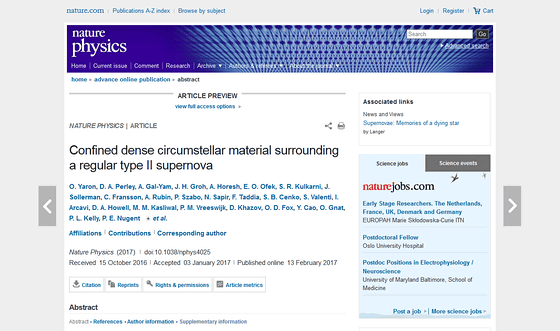Successful observation immediately after the occurrence of the supernova (Supernova), the last explosion of the star

ByStuart Rankin
The massive explosion phenomenon that occurs when large mass stars end their lifetime is "Supernova(Super Nova) "is called. It is thought that the supernovae is not clarified exactly and when it happens at the moment and statistically "There are no stars in the galaxy where supernovae will occur within one year as of 2017". A supernova that is such a very rare phenomenon, a research team including Weizmann scientific research institute reports that it succeeded in observing a young supernova of only 3 hours after it occurred.
Confined dense circumstellar material surrounding a regular type II supernova: Nature Physics: Nature Research
http://www.nature.com/nphys/journal/vaop/ncurrent/full/nphys4025.html

Scientists spotted a supernova just hours after it exploded | Popular Science
http://www.popsci.com/scientists-found-supernova-just-hours-after-it-exploded?con=TrueAnthem&dom=tw&src=SOC#page-2
A star is like a huge nuclear fusion reactor, and it undergoes a nuclear reaction in which an element such as helium heavier than hydrogen is generated. For stars that are more than 10 times heavier than the sun, they grow heavier as they grow older and ultimately iron cores are made. If a star runs out of hydrogen and the core becomes too heavy, it will eventually cause an explosive collapse, but such a supernova is "Type II supernovaIt is called.
According to a paper published to the Nature by a research team including Weizmann scientific research institute, it is said that "20 million light-years from the earth in 2013"SN 2013 fsA stellar named the supernova, and three hours after the explosion in the state of California, USAPalomar ObservatoryHe said that he has automatically detected supernovae. As a result of researches conducted by researchers on precious phenomena called supernovae that occurred so far, SN 2013fsRed giantIt caused a type II supernova, and it was observed that it spread at a speed of 224,000 mph (maximum speed 36593 km / h) at maximum speed.

In addition, the research team discovered that a phenomenon occurred in which the substance was ejected in the form of a disk around the fixed star one year before the explosion occurred. Mr. Offer Yaron of Weizmann Institute of Science explained, "As if a stellar knows when its lifetime is over, it will eject substances at a remarkable rate as the last disappointing," explains Supernova It is highly probable that it is a phenomenon of a forerunner that type II supernovae occupying more than half of the phenomena occurs.
In addition, the research team predicts that "the star spews a large amount of substance just before the supernova is generated and loses its mass before the core collapses", I believe it will lead to a mechanism of supernova generation which has not been completely elucidated I will. This is different from the hypothesis of conventional supernova generation, so it seems that it is unable to explain why stars come up with a large amount of substances at the end. In the latter half of 2017, the space telescope "ULTRASAT" will be able to observe celestial bodies with a precision 10 times higher than the Palomar Observatory, and it is expected that it will be able to detect the occurrence of supernova in a few minutes and unknown research of supernova It is expected that the field of.
Related Posts:
in Science, Posted by darkhorse_log







